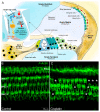Assessment and Management of Platinum-Related Ototoxicity in Children Treated for Cancer
- PMID: 32429551
- PMCID: PMC7281210
- DOI: 10.3390/cancers12051266
Assessment and Management of Platinum-Related Ototoxicity in Children Treated for Cancer
Abstract
Platinum compounds are a group of chemotherapeutic agents included in many pediatric and adult oncologic treatment protocols. The main platinum compounds are cisplatin, carboplatin, and oxaliplatin. Their use in clinical practice has greatly improved long-term survival of pediatric patients, but they also cause some toxic effects: ototoxicity, myelosuppression, nephrotoxicity, and neurotoxicity. Hearing damage is one of the main toxic effects of platinum compounds, and it derives from the degeneration of hair cells of the ear, which, not having self-renewal capacity, cannot reconstitute themselves. Hearing loss from platinum exposure is typically bilateral, sensorineural, and permanent, and it is caused by the same mechanisms with which platinum acts on neoplastic cells. According to available data from the literature, the optimal timing for the audiological test during and after treatment with platinum compounds is not well defined. Moreover, no substances capable of preventing the onset of hearing loss have been identified.
Keywords: cancer; chemotherapy; children; ototoxicity; platinum compound.
Conflict of interest statement
The authors declare no conflict of interest.
Figures

References
-
- Boulikas T., Pantos A., Bellis E., Petros C. Designing platinum compounds in cancer: Structures and mechanisms. Cancer Ther. 2007;5:537–583.
Publication types
LinkOut - more resources
Full Text Sources

